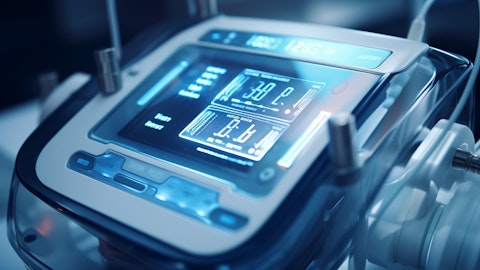Lishan Aklog: Yes. We didn’t mention that because that’s sort of the anchor of what we’re pursuing here in the near term, is with the large — our expectation in terms of very near opportunities are with there. But yes, we are still actively involved. We have discussions with 2 major biopharma companies. Just to remind everybody. Thanks for triggering the opportunity to talk about this, Ross. There’s a separate — related but separate opportunity to apply this platform technology in partnership with biopharma companies who are launching a large number of new cancer therapies, many of which are expensive and many of which are very intense in their therapy and can lead to complications and therefore can benefit from monitoring.
And these conversations are focused around the Phase IV, of the post-market surveillance aspect of this, where a drug — a new cancer therapy is launched but launched — is cleared and launched but only as a, say, third- or fourth- or even fifth-line therapy for patients who failed other therapies because of the still to be proven balance between safety and effectiveness. And so there’s a strong will and a strong interest with these companies to improve the outcomes during those Phase IV post-market surveillance studies and the opportunity for a remote patient monitoring platform to monitor and to enhance the safety of these drugs by picking up changes in the patient before they result in complications. And so yes, those are conversations that remain ongoing.
There’s a strong interest. There’s clearly a synergy. They are also long lead time conversations, they’re not going to happen overnight. But it does remain an important area of sort of strategic focus. But I would still emphasize the large academic centers as being sort of the linchpin of our near-term strategy.
Ross Osborn: Okay, great. And then, sticking with Veris. Would you provide an update on where you stand in the development work on next-gen PortIO offerings?
Lishan Aklog: For next gen, you mean for PortIO? I just want to make sure I heard you correct, Ross.
Ross Osborn: Yes.
Lishan Aklog: So PortIO is we use the first-generation device in the first-in-human study and that demonstrated really excellent results with no complications. We have a second-generation device that was in its late stages of development that enhanced some of the usability and structure, it has a built-in handle and a few other things. Fundamentally, the actual implantable portion was the same. So there’s a bit of additional work to get that through verification and validation testing and ready for use in a clinical study. So the — we haven’t decided yet as to whether we’re going to proceed. But I would say the most likely path, if we can secure financing for PortIO in the near term, would be to proceed with the IDE with the first-generation device and then transition into the second-generation midstream if that becomes ready.
We’re real anxious to start an IDE study. We’ve done spent a lot of time with FDA over the previous years on fine-tuning a variety of preclinical work as well as various aspects of the study design. We think we’re in a good position to get an approved IDE based on the first in-human results which we were gearing to do when we stopped the develop — when we paused the development work a year ago. So that’s pretty much where we stand. Hopefully that answers your question, Ross.
Operator: Your next question comes from Ed Woo with Ascendiant Capital.
Ed Woo: My question is on the recently announced incubator that you guys are developing. Have you — what is your exact responsibility? Any financial commitments to — for the incubator?
Lishan Aklog: So the incubator is a wholly owned subsidiary of PAVmed, so it’s 100% owned. It’s just structurally, we’re dropping those assets into the incubator. And we’re seeking to, on a product-by-product basis, secure individual financing, just like you would with a freestanding incubator seeking to secure financing for the development and commercial — regulatory clearance and commercialization of each individual product. And that would be in a separate subsidiary where there would be additional stakeholders, including anybody who finances that particular. So there’s an opportunity to finance individual products. We have a partnership with Hatch Medical that would — that incentivizes them to sort of help with that process on an individual product-by-product basis. But the incubator itself remains wholly owned by PAVmed. Dennis, do you want to add any color to that?
Dennis McGrath: Yes. So the game plan here is to have a joint venture with Hatch where they will provide capital. We will provide talent, engineering knowledge and know-how about the market. And ultimately, once a decision is made about whether this is fully commercialized or we’ll look to partner with a commercial entity, Hatch has the ability to broker that transaction as well. So the full service entity that can provide both financing, development work, the exit and brokerage, combined with the talent that we have internally, to bring this to its full realization.
Lishan Aklog: Just one point of clarification. So the it will be the entities, the PAVmed entity or subsidiary of the incubator that will be raising the capital. Our partnership with Hatch is designed to help in all aspects, whether it’s helping introduce to potential financial partners, angel networks and also participate in the development. And ultimately, as Dennis said, an area where they’ve had great success over the years in brokering commercial and strategic transactions.
Operator: Your next question comes from Nick Sherwood with Maxim Group.
Nick Sherwood: For the incubator, do you plan on being the majority owners of those products that are spun-off of the incubator? Or are you open to having minority stakes in CarpX or any of the other products?



